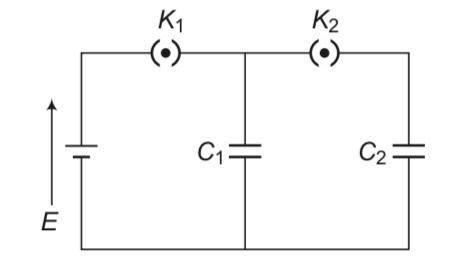In the circuit shown in figure initially key K1is closed and key K2 is open. Then K1 is opened and K2 is closed (order is important). [Take Q’1 and Q’2 as charges on C1 and C2 and V1 and V2 as voltage respectively.] Then, E
(a) Charge on C, gets redistributed such that V1 = V2
(b) Charge on C1 gets redistributed such that Q’1 = Q’2
(c) Charge on C1 gets redistributed such that C1V1 + C2V2 = C1E
(d) Charge on C1 gets redistributed such that Q’1 + Q’2=Q

In the circuit shown in figure initially key K1is closed and key K2 is open. Then K1 is opened and K2 is closed (order is important). [Take Q’1 and Q’2 as charges on C1 and C2 and V1 and V2 as voltage respectively.] Then, E
(a) Charge on C, gets redistributed such that V1 = V2
(b) Charge on C1 gets redistributed such that Q’1 = Q’2
(c) Charge on C1 gets redistributed such that C1V1 + C2V2 = C1E
(d) Charge on C1 gets redistributed such that Q’1 + Q’2=Q

-
1 Answer
-
This is a multiple choice answer as classified in NCERT Exemplar
(a), (d) Initially key K1 is closed and key K2 is open, the capacitor C1 is charged by battery and capacitor C2 is still uncharged. Now K1 is opened and K2 is closed, the capacitors C1 and C2 both are connected in parallel. The charge stored by capacitor C1, gets redistributed between C1 and C2 till their potentials become same, i.e., V2 = V1.
By law of conservation of charge, the charge stored in capacitor Cx is equal to sum of charges on capacitors C1 and C2 when K1 is opened and K2 is closed, i.e., Q...more
Similar Questions for you
This chapter covers the concepts of potential, capacitors, and potential energy. It is considered as one of the easy chapter of the class 12 Physics.
It is the farad (F). The name came from Michael Faraday. SI Unit of Capacitance means the ability of a system to store an electric charge. One farad is the capacitance of a device that needs one coulomb of charge to provide one volt potential difference across it. Mathematically, it is represented by - 1 Farad = 1 Coulomb/Volt.
In JEE Main Physics, electric potential and capacitance chapter has a weightage of 3% to 6%. You can expect around 1 or 2 questions from this chapter which carries 4 to 8 marks.
In NEET Physics exam, the chapter electric potential and capacitance carries a weightage of 2% to 5%, which means you can expect one question out of 45 questions.
The ability to do work on a charge is called the electric potential and the ability to store charge is termed as the capacitance.
Taking an Exam? Selecting a College?
Get authentic answers from experts, students and alumni that you won't find anywhere else
Sign Up on ShikshaOn Shiksha, get access to
- 65k Colleges
- 1.2k Exams
- 679k Reviews
- 1800k Answers
